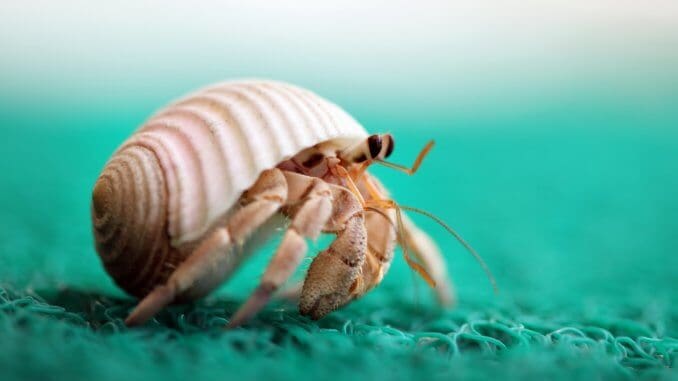
Hermit Crabs are curious crustaceans, their strange behaviors and different personalities are sure to put a smile on the face of beginner and expert keepers alike.
They require a lot of care and you will need to keep a close eye on them to spot any health problems they may have.
Throughout this article, we will introduce you to the most popular hermit crab species and give you an in-depth understanding of what it takes to keep this invertebrate.
We will be covering everything you need to know from general care and feeding requirements to breeding tips, as well as some interesting facts along the way.
TABLE OF CONTENTS
Hermit Crab Facts & Overview
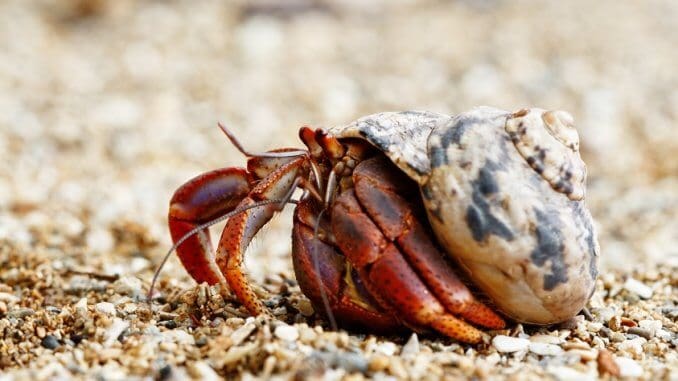
| Category | Rating |
| Care Level: | Moderate |
| Temperament: | Generally peaceful, but species dependent |
| Color: | Species dependent |
| Lifespan: | Up to 30 years |
| Size: | 0.5-40 inches |
| Diet: | Opportunistic omnivore |
| Family: | Paguroidea |
| Minimum Tank Size: | 10 gallons |
| Tank Setup: | Saltwater reef system or shoreline (species dependent) |
| Reef Compatibility: | Yes, depending on species |
Hermit crabs belong to the superfamily Paguroidea which is comprised of well over 800 separate species, possibly even over a thousand.
There are seven different families to which these species belong.
One family is the Coenobitidae which is comprised of land-dwelling Hermit Crabs. The other six families are classified as water-dwelling species.
Unlike many decapod crustaceans, Hermit Crabs have a soft abdominal region. In order to protect themselves, they have adapted to have curved bodies that fit into scavenged mollusk shells.
These fascinating creatures can live for as long as 30 years in the wild. However, their lifespan in aquariums is usually a lot shorter than this. These aquatic or land-based crustaceans make a unique pet and are not that easy to find a local fish stores. There are however lots of places online where they can be bought.
The cost can vary drastically with the individual species ranging from $3 all the way up to $60.
Typical Behavior
Hermit Crabs are generally peaceful and social organisms that live in large groups in the wild.
Larger species will be more aggressive than smaller species and may even attack your fish.
Smaller reef compatible species are mostly peaceful however, you may find that they fight with each other. This is completely normal behavior and it is called rapping (which essentially is a battle to get another crabs shell).
You can avoid this sort of behavior by adding plenty of different-sized and shaped shells throughout the substrate. You will find they tend to occupy the lower regions of the tank. However, they are also good climbers so you may find them on live rocks in between the reef.
They can be quite shy and may choose to hide inside their shell whenever you approach the tank.
Facts
- They are omnivores and need a varied diet of algae and protein. Foods that are high in carotene will give them brighter colors, especially if they are a red or orange color.
- Marine and land-dwelling species both use their gills to breathe. Marine species exchange carbon dioxide for dissolved oxygen in the water column, whereas land species breathe air and will drown if kept in water.
- They need larger shells as they grow, so they usually steal them from other crabs.
- As with all crustaceans, they shed their exoskeleton as they grow. Younger specimens shed their exoskeleton more than adults, as the grow rate slows drastically with age.
- They have soft asymmetrical abdomens which need to be protected by a shell. Without their shell, they become vulnerable to predation.
Appearance & Types
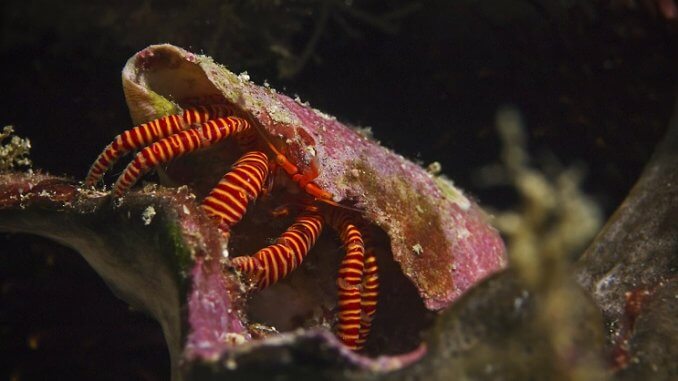
The appearance of these decapods varies between each individual species.
Generally, most Hermit Crabs have one thing in common. They have long, soft abdomens which are spirally curved in order to allow them to anchor themselves within the scavenged shells of mollusks.
The shape of their shell is not very important as they continuously change their shell as they grow too large for their previous one.
All Hermit Crabs belong to the order Decapoda which literally translates to ten-legged. They have ten appendages including their claws.
The color of these little creatures is totally dependent on the species. One thing that all of these crustaceans have in common is that at certain points of their lifecycle their color can become duller or brighter (more on this later).
Once again, the size of the organism is dependent on the species.
- One of the smallest species (the Ecuadorian Hermit Crab) only grows to 0.5 inches.
- The largest species (the Coconut Crab) can grow to a size of up to 40 inches.
Hermit Crab Species
The Blue Leg Hermit Crab
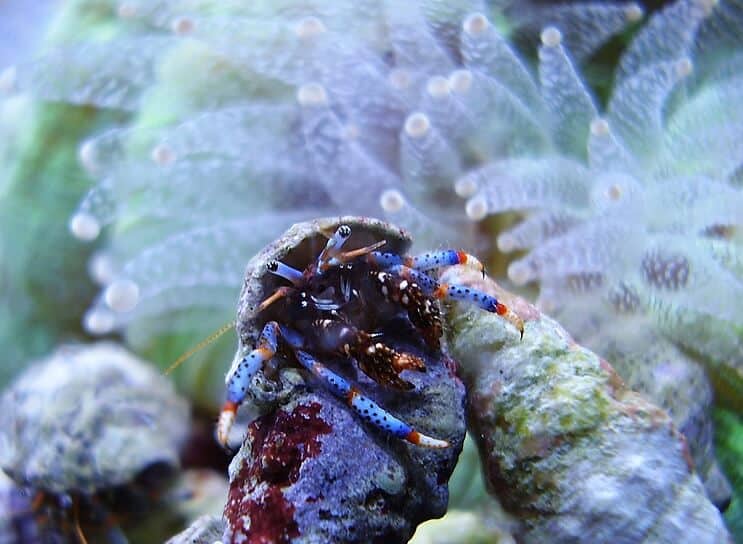
Also referred to as the Dwarf Leg, this species is native to the Caribbean. They grow to around 1 inch and unsurprisingly they have blue legs. Their legs also have small red bands.
Their claws are a mixture of blue, orange, and reddish-brown with white spots.
The Strawberry Hermit Crab
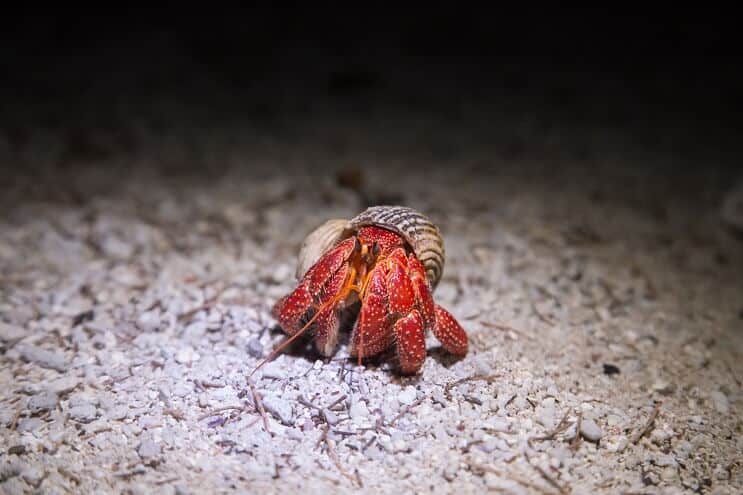
This is an extremely attractive species due to its strawberry-like deep red coloration with small white spots. They grow to a size of up to at least 6 inches and require plenty of space.
They are a land-dwelling Hermit of the family Coenobitidae, who inhabit the coastal shorelines of the Pacific Ocean.
The Ecuadorian Hermit Crab
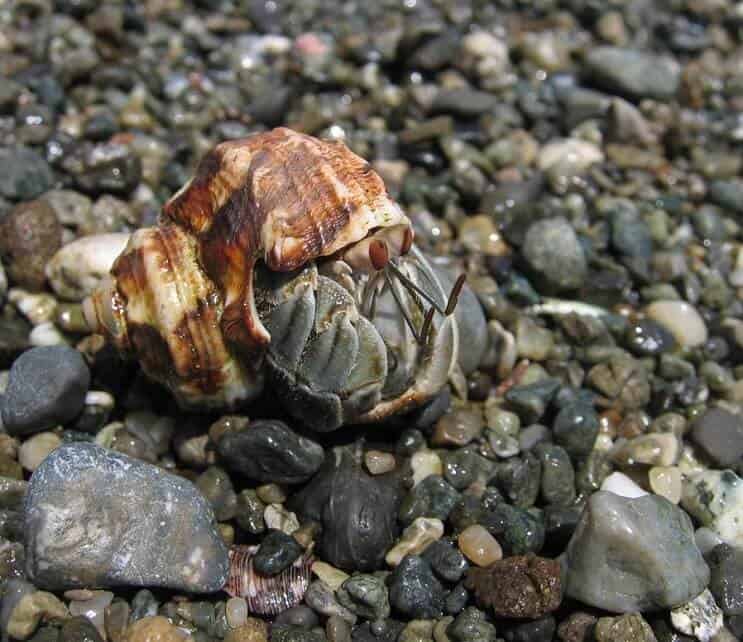
These crabs are also known as Pacific Crab.
They are native across the Pacific coastline of Central and South America. As previously discussed, they are one of the smallest members of the land-dwelling species and grow to 1 inch.
Their color varies with age, with young specimens having bright blue, green or yellow coloration. As they age, their color changes to shades of different colors including orange, yellow, green, and others.
Read this Article: Corner Fish Tank (Setup Ideas, Equipment, Stocking And Much More…)
Other Hermit Crabs:
| Crab | Description |
|---|---|
| The Coconut Crab | This is the largest member of the Coenobitidae family growing to a staggering 40 inches. They are also extremely dangerous to handle, their large powerful claws can exert bone crushing pressure. |
| The Scarlet Reef Hermit | This species also goes by the name Red Reef or Red Legged Hermit for the deep red coloration of its appendages. This crab also has a yellow face with small green eyes at the top of the eye stalks. |
| The Electric Blue Hermit | This is another popular reef dwelling species native to the Marshall Islands and is perfect for your home aquarium. They have stunning coloration as they sport electric blue legs as their name suggest with the addition of black bands. |
Tank Conditions and Natural Habitat
Hermits can be divided into two categories: land and water-dwelling species.
They are both found throughout the world in completely different habitats.
Land species are found along tropical coastlines. They need to be near the ocean or freshwater streams to keep their gills moist in order to respire. They also return to shallow saltwater to breed.
Water-dwelling species like the Halloween Hermit, spend their entire lives within the Indo-Pacific ocean. Here the water temperatures range from 71-83°F and there is a pH of between 8.1-8.4. The specific gravity is in the region of 1.020-1.025.
They are found inhabiting reef systems near to the shore so they need a decent water flow as they would naturally encounter tidal cycles and currents which pass over the reef.
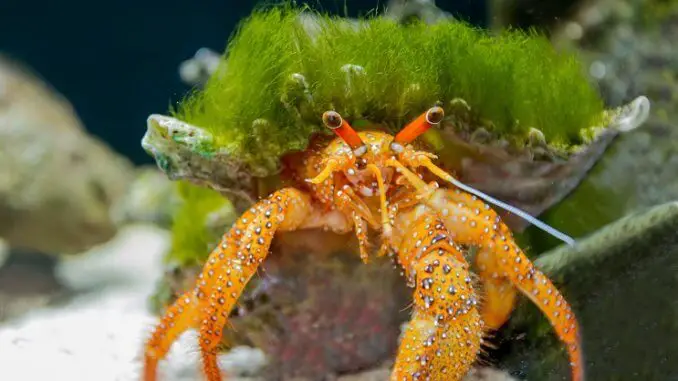
Tank Setup
Because there are so many different species that all require different tank conditions, we will give a general overview here.
However, the most important thing to remember is your tank setup should closely resemble those that the species would encounter in their natural habitat. A large majority of them need the water parameters listed above.
A good filtration system will provide multiple benefits to the tank. Filters not only clean the water by removing suspended particles, they also provide biological filtration and water flow throughout the aquarium.
Be sure to purchase a filtration system that either meets or exceeds the tank’s required filter size.
The addition of seaweeds like sea lettuce will absorb excess nitrates from the water. During photosynthesis, the plant will also remove carbon dioxide from the water and replace it with dissolved oxygen which your inhabitants need to breathe.
LED lighting systems are a great option for providing the correct amount of lighting for reef systems although they can be fairly expensive.
A sandy substrate and plenty of live rock should be added to the tank to make it more natural. It will also provide additional areas for good bacteria to grow and filter ammonia and nitrites.
You will also need to complete a nitrogen cycle before adding any crabs to your tank – this can take up to 8 weeks.
Remember to do your research and make notes of the specific requirements each Hermit species needs, as well as any fish species so that you can choose species that can coexist in the same tank with each other.
What Size Aquarium Do Hermit Crab Need?
The size of the aquarium they need will depend on the size of the Hermit you want to keep.
As a general rule smaller hermit crabs need 1 gallon of water. So a 20 gallon tank would house 20 small species such as the Scarlet Reef Hermit.
For larger species like the Halloween Hermit, keep 1 per 2 gallons of aquarium water.
Tank Mates
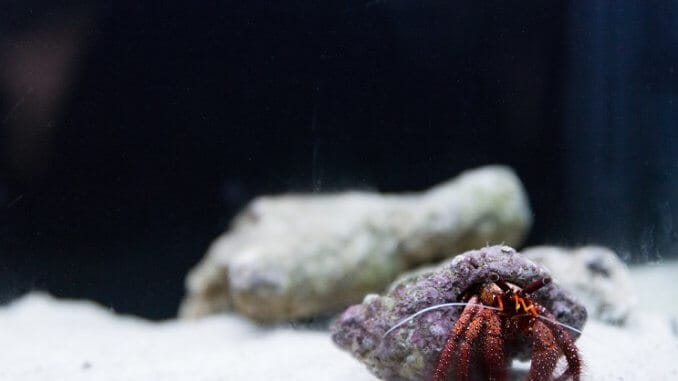
Within their wild habitats, these creatures are found coexisting with various organisms including fish and other invertebrates.
Reef-dwelling species will be found with a lot of different fish from all over the world including Clownfish, Butterflyfish, Damselfish, and Gobies.
There are many popular species that can be kept with Hermits and a good place to start is with ones they would encounter in the wild. The fish mentioned above are all great tank mates.
Other species like small Wrasses, Pajama Cardinalfish, Firefish, and Royal Gramma are also excellent options – Mandarin fish also make good tank mates. They also do well in the same tank as cleaner shrimp which provides a useful service to the aquarium by removing algae and cleaning the other inhabitants.
Aquatic plants will also be beneficial. Species like Green Finger Algae, Dragons Tongue Algae, and Halimeda plants are all great examples.
Avoid keeping any predatory species like Groupers, as well as beaked species such as Parrotfish, Triggerfish, and Pufferfish.
Keeping Hermit Crabs Together
Keeping Hermit Crabs together depends on the species you are looking to keep.
Generally, all small and peaceful reef-dwelling species can be housed with one another.
Diet
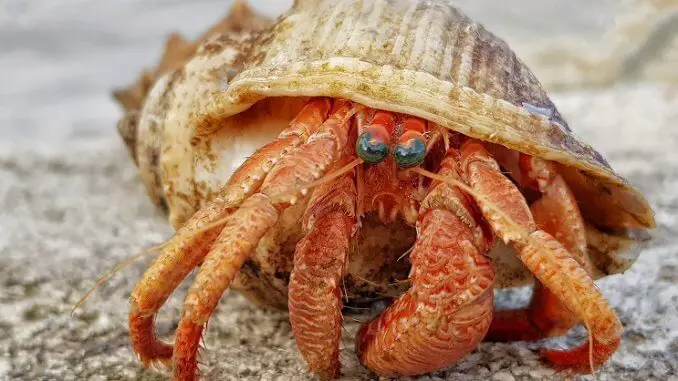
These decapods are scavengers which means they will eat almost anything they find – in the wild they will feed on things like green and red algae as well as dead organisms like fish, shrimp, and other decaying matter.
Hermits will actively hunt snails as a food source but also to get their shells.
They tend to make awesome cleanup crews for any tank – they eat unwanted algae like green hair algae and red slime algae. They are also exceptionally good at sifting through the tank’s substrate in search of any uneaten food and decaying matter.
Feeding your Crabs a varied diet is very important for their health and they should be fed a diet of sinking vitamin enriched pellets. Food should be provided in small quantities twice daily, preferably in the morning and early evening.
If you do not have vast quantities of algae in your aquarium, then you should be providing dried seaweed or spirulina algae wafers as well as other foods.
You can feed them high protein foods such as fresh sardines and tuna every now and then to supplement their diet.
Care
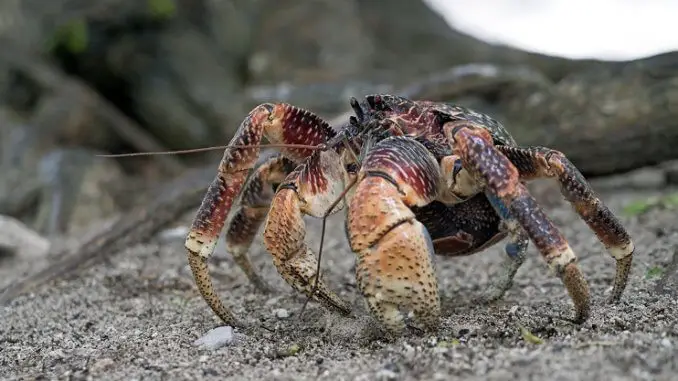
Hermit Crabs need a lot of attention and care.
Firstly, they need to be kept under the correct conditions and in a habitat that matches their natural wild environment. If these are not met, it can cause stress which leaves them vulnerable to diseases and parasites.
Land-dwelling species need a lot more care and attention than water-dwelling ones.
Shell rot is a common disease that affects them, it is caused by bacteria that break down the chitin in their exoskeleton. This creates holes and can lead to secondary more severe infections.
Feeding your creatures contaminated seafood like shelled Oysters or Mussels or poor hygiene conditions within the tank can both lead to shell rot.
Any shelled seafood you choose to feed them should be boiled to kill any bacteria and fungi.
Hermits can get rid of shell rot on their own by shedding their exoskeleton. The only treatment for this disease is good quality water which should be provided at all times to help the crab heal itself.
Another common infection is fungus. Fungal infections look like fluffy spots on your Hermit Crab and can be caused by excess humidity.
If you spot a fungal infection, you will need to bathe them in saltwater.
Breeding
Breeding Hermit Crabs can be extremely difficult even for experienced hobbyists.
Getting them to breed is the easy part.
The problem actually lies with the rearing of the young. Like all crustaceans, they produce planktonic larvae, and therefore trying to breed them in an established reef system is simply not a viable option.
Molting
The process of molting is where the organism sheds its exoskeleton.
They do this because as they continue to grow, their hard exoskeleton does not grow with them and so they need to remove this exoskeleton to allow them to grow larger.
Healthy specimens shed their exoskeleton once every 18 months. Juveniles on the other hand molt around once a month until they mature.
Prior to the molting process, they will become slightly duller and less colorful.
When they have shed their exoskeleton, do not remove it from the tank as they will begin to eat it – it is full of essential calcium which it required for strengthening their new exoskeleton.
At this point you should begin to supplement them with calcium-enriched foods also.
Are Hermit Crabs Suitable For Your Aquarium?
Hermit Crabs are found throughout the world in various environments (both land and ocean systems).
Before you bring a Crab home make sure you do lots of research into their specific care requirements.
If their needs are not met it can cause stress which can leave them prone to infection and disease.
There are a lot of small Hermit species available which can be kept in a 20-gallon aquarium, but if you are looking for a larger species then you are going to need a bigger tank.
Have you ever kept Hermit Crabs? Let us know in the comments section below…

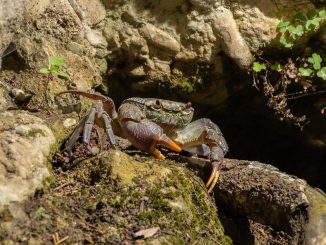
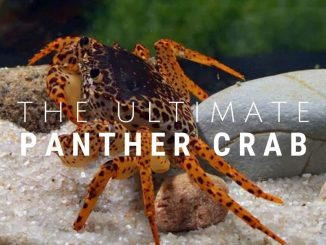
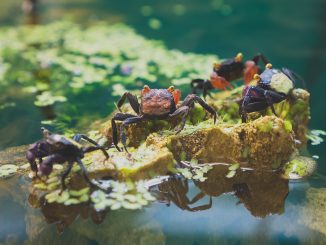
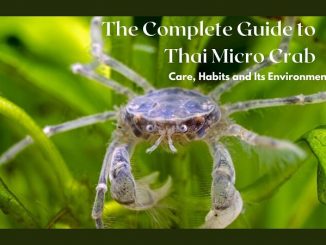
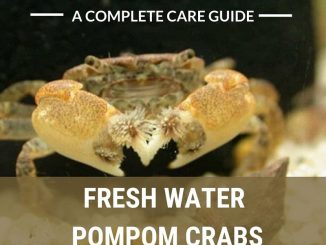
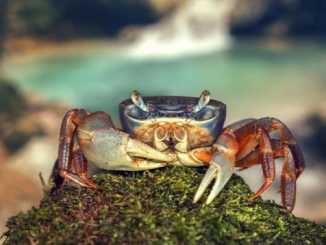
Be the first to comment